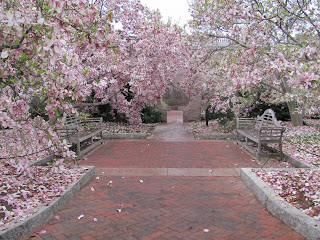Last Friday I was fortunate enough to have some downtime in my schedule for a walk through the Enid Haupt Gardens at the Smithsonian. I'd say, as far as enjoying the blossoms of Magnolia x. soulangiana, my timing couldn't be more perfect. I always love flowering trees most when half the petals are on the ground, and half still on the tree.

Strangely enough -- and I've never noticed this before with saucer magnolia -- but the landscape smelled a little like pizza. Now then, maybe I was just hungry, but I think when the petals start to decay they have a slight aroma of parmesan.
I love the boldness of using so many of this tree, and against the brick, the petals weren't even that slippery (on smoother surfaces they can be like banana peels). The shots above are at the entry to the Moongate Garden, which was part of the renovation of the Enid Haupt Gardens in 1987.
In the photo above is the Moongate itself (there are actually two in the garden). It's hard to read thsi time of year since the pink granite blends so well with the Magnolia petals. Below is a more clear shot.
Approaching the Moongate, the paving changes to granite with notches of Belgian block. The Moongate Garden is inspired by the Temple of Heaven, built in Beijing during the Ming Dynasty (14-17C).
The round granite stone placed in a square pool represents heaven and earth. The square is earth, heaven is the circle. Strangely enough, I can't find much written on the symbolism of the four pathways to "heaven." Below, they are represented as stone bridges over the water. At the actual temple, they are entry points to the circular landform.
Perhaps the use of four here isn't as deliberate as the circle and square, but the concept of four being a symbolically rich number is prevalent. The number four appears often in Hinduism and it's believed in that religion there are four paths to meet God. The garden of Eden was believed to be accessed by four different rivers and, as such, many gardens mean to represent Eden have four waterways included in the design. In Buddhism there are four noble truths. In Islam, there are four sacred months and four archangels. In Judaism, during passover, there are four cups of wine to be drunk, four sons to be addressed and four questions to be asked.
Finally, perhaps most darkly -- there are four horsemen of the apocalypse...!






No comments:
Post a Comment